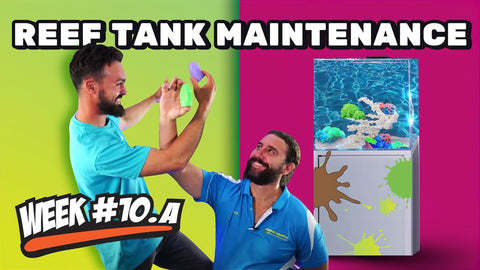Nuisance Algae And Pests In Saltwater Aquarium | 12 Week Reef Video Tutorial #11
Coral Reef Tank Pests, Nuisance Algae in Reef Tanks, and Secrets for Rapid Coral Growth
Week 11 of your reef tank journey is here, and it's all about managing coral reef tank pests and combating nuisance algae in reef tanks. A balanced reef tank ecosystem can have rapid coral growth and vibrant colors, but that balance can be disrupted by common pests and algae. We’ll cover not only pest control but also tips for faster coral growth, from dosing with coral essentials CVE packed with B vitamins, to adjusting flow using random flow generators. Stick around to see how manganese can help your Goniopora coral reach its full potential.
Pest Management in Coral Reef Tanks
Over recent years, as more reef hobbyists shift to natural aquascaping products like Marco Rocks rather than live rocks from the reef, issues with coral reef tank pests have declined. However, some microscopic pests remain common, even in well-maintained tanks. Among the most common are aiptasia, flatworms, and bristle worms. These pests can be controlled naturally by choosing fish and invertebrates known to consume them, or through reef-safe medications.
Dealing with Nuisance Algae in Reef Tanks
Nuisance algae in reef tanks is a familiar issue for reefers, but it doesn’t need to ruin your setup. Nuisance algae often appear because of nutrient imbalances (like high nitrate and phosphate levels), insufficient flow, or fluctuating parameters. Some of the most persistent types of algae include red cyano, bubble algae, and dinoflagellates. These fast-growing algae strains can compete with corals for nutrients, reducing coral growth and color vibrancy. Ensuring your corals are growing quickly and thriving can naturally help outcompete nuisance algae for space and nutrients.
The Coral Cheat Code: Maximizing Growth and Color
A reliable way to boost crazy coral growth using coral essentials CVE can make a visible difference in your tank. Dosing coral essentials directly into the tank, or even using a dosing pump, can support fast coral growth, helping corals outcompete nuisance algae. Another helpful element for coral health is manganese for goniopora—a powerful addition that promotes optimal growth and maintains their stunning colors. Coral essentials can act as a cheat code to maintain coral vibrancy and help them thrive.
Increasing Flow with Random Flow Generators
Another essential component for a balanced reef ecosystem is the installation of random flow generators for increased flow in random areas. These tools ensure that your tank has no dead zones, where water and nutrients can stagnate. By increasing flow variability, corals can receive adequate nutrition while waste is efficiently removed from the tank. Adding a random flow generator supports coral health and helps prevent both nuisance algae and pests from establishing strongholds.
Weekly Wrap-Up
With pests under control, boosted coral growth, and improved water flow, your tank is well on its way to being a thriving reef ecosystem. Week 12, the finale, is just around the corner—don’t miss out on the last stretch of this reefing journey!





